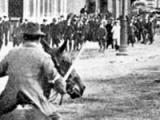The mine exploded at 3.44 p.m. on Friday 19 November 2010. Twenty-nine of the 31 men underground died immediately or soon afterwards from the blast or because of the toxic atmosphere this generated.
Coal Mining
Events In History
Nineteen men were killed when an explosion ripped through the Strongman coal mine at Rūnanga. An inquiry found that safety regulations had not been followed and a shot hole for a charge had been incorrectly fired.
At 7.20 a.m. an explosion at Ralph's mine on Raynor Rd rocked Huntly. It was caused by a miner's naked acetylene cap-lamp igniting firedamp (methane gas given off by coal)
Articles
1947 Greymouth beer boycott

What would it take for West Coasters to boycott their beloved beer? Greymouth hotel-keepers found out in 1947, when an organised attempt to raise the price of beer sparked one of the most effective consumer boycotts ever seen in New Zealand. Read the full article
Page 4 - Industrial action
After the first week of the Greymouth beer boycott it became clear that the Licensed Victuallers' Association (LVA), supported by the breweries, was not going to yield.
Seddonville

The West Coast coalmining settlement of Seddonville, 50 kms north of Westport, was named in honour of the Liberal Premier Richard Seddon. It was also the site of an early experiment in state socialism – New Zealand's first state coal mine opened there in 1903. Read the full article
Page 1 - Seddonville: forgotten coal town
The West Coast coalmining settlement of Seddonville, 50 kms north of Westport, was named in honour of the Liberal Premier Richard Seddon. It was also the site of an early
Page 2 - Coal is discovered
After John Rochfort discovered fragments of bituminous coal in a river north of Westport in 1859, the search was on for accessible coal seams that could be
Page 3 - Seddonville State Mine
Premier Richard Seddon decided that the best way to challenge the coal companies was to establish government-owned mines that would provide cheaper coal as well as
Page 4 - Mining at Charming Creek
The block of coal discovered in the headwaters of Charming Creek created interest after the closure of the state
Page 5 - Hydraulic coal mining
There are major advantages to using hydraulic mining for coal, including the lack of dust as well as minimising the risk of explosions and
Page 6 - Decline of mining
After 1956 there was a sharp decline in the demand for coal as many customers changed to oil.
Page 7 - Seddonville's rail heritage
The Ngakawau-Seddonville branch line was built solely for the transport of coal from mines near Seddonville to Westport harbour, where it was then transported around New Zealand
The 1913 Great Strike

The Great Strike of 1913 was in fact a series of strikes between mid-October 1913 and mid-January 1914. It was one of New Zealand’s most violent and disruptive industrial confrontations. Read the full article
Page 3 - Outbreak of the 1913 strike
The 1913 Great Strike was sparked off by two relatively small
Page 6 - The 1913 strike in the South Island
Although the 1913 strike had its biggest impact on Auckland and Wellington, the South Island's cities and mining towns were also
Pike River mine disaster
On the afternoon of 19 November 2010, an explosion ripped through the remote Pike River mine on the West Coast of the South Island, killing 29 men. Read the full article
Page 1 - Pike River mine disaster
On the afternoon of 19 November 2010, an explosion ripped through the remote Pike River mine on the West Coast of the South Island, killing 29
























































